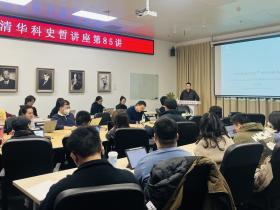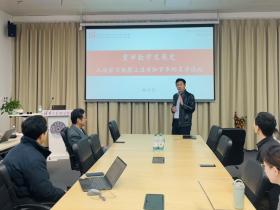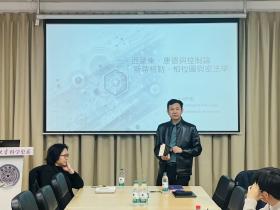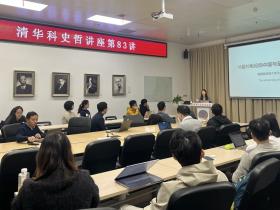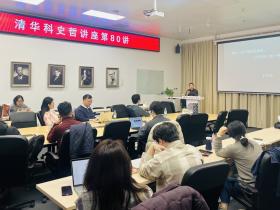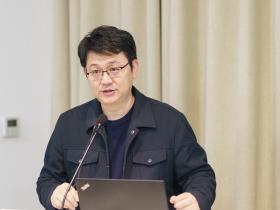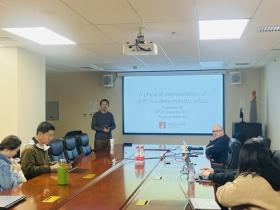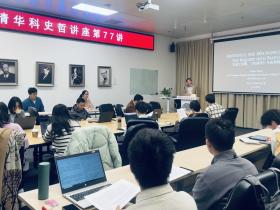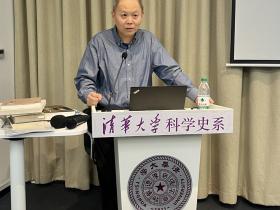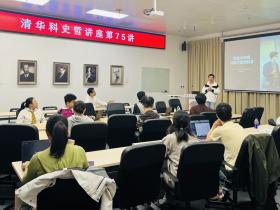On the evening of June 21, 2024, the Department of History of Science hosted the 68th lecture in the THU History and Philosophy of Science Lecture Series. The invited speaker was Associate Professor Akihisa Setoguchi from the Institute for Research in Humanities, Kyoto University. The lecture was titled "The Environmental History of Disasters: Humans, Science, and Insects." The event was chaired by Associate Professor Shen Yubin from the Department of History of Science, with nearly twenty faculty members, students, and peers from within and outside the university participating offline.
At the beginning of the lecture, Professor Shen Yubin introduced Professor Setoguchi's academic interests and publications. Professor Setoguchi's research primarily focuses on the history of science, STS (Science and Technology Studies), and environmental history, with a particular emphasis on the complex relationships between humans, nature, and the life sciences. He is a prolific author, with notable works including his monographs The Birth of Pests: A History of Japan from an Insect's Perspective and *The Environmental History of Disasters: Scientific and Technological Society and the COVID-19 Pandemic*.

In the first part of the lecture, Professor Akihisa Setoguchi traced the construction of the concept of "pests" (gaichū) in modern Japan. Before the late 19th century, there was no modern concept of "pests." Insects like locusts and planthoppers fell under the broader, more ambiguous category of "insects" (mushi). Insect infestations were seen as natural disasters beyond human intervention, and Japanese farmers often relied on religious rituals to pray for protection. However, by the late 19th century, the Japanese government enacted the Pest Control Act (Gaichū Kyojō Bōshi Hō), defining the concept and targets of "pests" and mandating farmers to control infestations. Through educational channels, government agencies shaped the image of "pests" as human enemies using textbooks and pest-control songs, frequently organizing elementary school pupils to collect pests as a practical control measure. By examining the history of the "pest" concept's formation, Professor Setoguchi highlighted how technoscience presents a facet of intervening in and transforming nature as a human tool.
In the second part, Professor Setoguchi discussed the relationships between science, technology, and human society as reflected in events like the Great East Japan Earthquake (3.11) and the COVID-19 global pandemic. Following these events, the Japanese government utilized systems like SPPEDI to monitor the spread of nuclear radiation and various epidemiological parameters of the pandemic. For the first time, the government also relied on mathematical modeling and other technological means to formulate epidemic prevention policies. Similar approaches using technology to determine epidemic response measures were also seen in countries like the UK. Inspired by these cases, Professor Setoguchi pointed out that technoscience constantly envelops human society, becoming the environment itself. Simultaneously, nature is subjected to surveillance and observation by technoscience.
In the third part, Professor Setoguchi revisited his earlier research based on these insights, discussing modern Japanese methods for tracking and controlling pests. He noted that since 1941, Japan has deployed a large network of monitoring stations to track pest populations. Pest counting spurred a series of standardization processes, including specifications for insect traps, operational methods, and counting techniques. Beyond establishing monitoring stations domestically, the Japanese government also set up observation points at sea to attempt to count pests and identify their origins, collaborating with countries like China and South Korea to form an international monitoring network. Today, pest monitoring involves close collaboration with academic institutions. Utilizing technologies like computer simulations, it has achieved high precision, enabling effective pest detection, prediction, and ultimately, prevention and control. Concluding the lecture, Professor Setoguchi argued that technoscience possesses the dual characteristics of both transforming nature and surveilling it. Unlike purely natural events, disasters defined by human society undergo complex processes of identification and definition, essentially being constructed within human society itself.

Following the lecture, a lively discussion took place between the attending faculty, students, and Professor Setoguchi. Questions raised included: "How to distinguish between 'disaster' and 'catastrophe'?", "Is there a parallel relationship between surveilling nature and surveilling human behavior?", "Does the emergence of surveillance practices in human society form a causal relationship with the identification of disasters?", "Were female students neglected in school pest collection activities?", and "What are the similarities and differences between Applied Entomology and Economic Entomology?" Professor Setoguchi addressed each question with detailed analysis.
Professor Shen Yubin, Sun Chengsheng, Liu Niankai, and Liu Xiao from the Department of History of Science also engaged Professor Setoguchi in discussions related to their respective research fields and interests. Professor Shen Yubin further inquired about the general landscape of history of science research in Japan and opportunities for exchange visits. Professor Setoguchi provided an overview of the distribution of Japanese schools of history of science, research focuses and trends, teaching characteristics, and information about visiting scholar opportunities at the Institute for Research in Humanities, Kyoto University, warmly welcoming participants to visit Kyoto University. With this, the THU History and Philosophy of Science Lecture concluded successfully.
Documented by: Lin Zihan
Reviewed by: Shen Yubin


